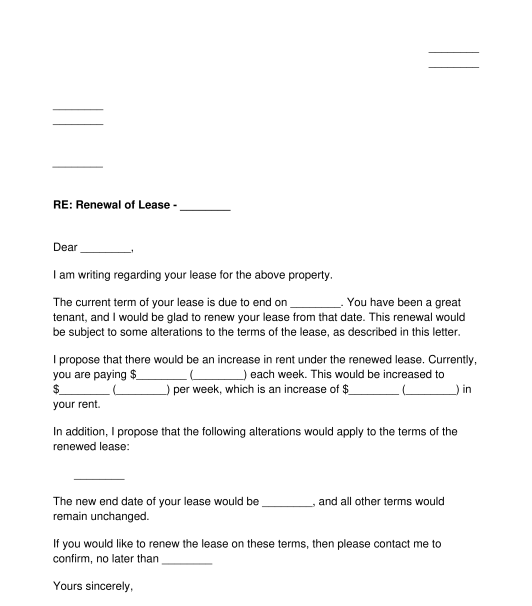 15/10/2025
15/10/2025

Answer a few questions and your document is created automatically.

Your document is ready! You will receive it in Word and PDF formats. You will be able to modify it.

 15/10/2025
15/10/2025
 Word and PDF
Word and PDF
 1 page
1 page
This Letter Offering Lease Renewal can be used by a landlord when the lease for their property is coming to an end. The letter can be sent to the tenant, to remind them that the lease will be ending soon, and to offer to renew the lease.
Within the letter, the landlord can also notify the tenant of any proposed changes to the terms of the lease. For example, if the landlord is proposing to increase the rent, or to change some other terms of the lease, these changes can be summarised within this letter.
Under Australian laws, in most cases the landlord will have to give the tenant a certain amount of notice if the rent is being increased, or if other terms of the lease are going to be updated. By sending this letter to the tenant, before the lease ends, the landlord can retain a written record, confirming that they provided adequate notice of any relevant changes.
Furthermore, it is in the landlord's interests to work out what the tenant would like to do, so that the landlord can make appropriate arrangements. For example, if the tenant is not going to renew the lease, then the landlord will need some time to organise a replacement tenant. This letter helps the landlord to work this out and to obtain formal confirmation from the tenant.
Firstly the landlord should review their lease and any relevant tenancy laws to make sure they are providing adequate notice. If they are proposing to make changes to the lease, then they will need to confirm that they are legally entitled to make the changes that they intend to make.
This notice allows the landlord to propose changes to the terms of the renewed lease, and to seek the tenant's confirmation whether they would like to continue leasing the property under those new terms.
Once the letter has been prepared, the landlord should send a copy to all tenants on the lease. The landlord should keep a copy for their own records. The landlord should also keep evidence of the fact that they have provided sufficient notice to the tenant (for example, a send receipt or a copy of an email confirmation), in case the tenant later disputes having received the notice.
The landlord should send the letter to the tenant early enough to comply with relevant notice requirements, and to give them time to either prepare a lease document, or find a new tenant (depending on whether or not the current tenant wants to renew the lease).
Once the landlord hears back from the tenant, they can prepare a new lease, or can make arrangements to find a new tenant.
Different laws may apply to this matter depending on which state or territory the property is located in, and whether the property has been leased for residential, commercial or retail purposes.
Retail leases are a sub-category of commercial leases (usually for properties that involve a "retail" element, such as a shop front). The laws in each state and territory regarding retail leases also provide more protections to tenants of retail properties than those of ordinary commercial properties.
Each state and territory also has its own legislation regarding residential tenancies.
Leases are also subject to general principles of contract law, as provided by the common law.
Further information or legal assistance, particularly in relation to residential properties is available from consumer affairs offices, tenant unions or tenant advice services in each state and territory. Community legal centres may also provide assistance.
You fill out a form. The document is created before your eyes as you respond to the questions.
At the end, you receive it in Word and PDF formats. You can modify it and reuse it.
Guides to help you
Letter Offering Lease Renewal - sample template
Country: Australia